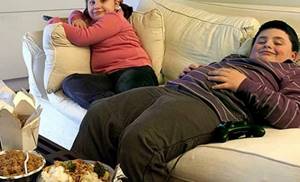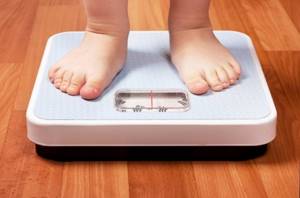Tips for success
What to do if children are overweight
The best weight control strategies are those that you can maintain for life. It's a long time coming, so we'll try to keep these suggestions as simple as possible!
Make it a family affair
Ask mom or dad for help and support. The goal is to make diet or lifestyle changes that benefit the entire family. Teenagers who have family support tend to have better outcomes.
Watch your drinks
It's amazing how many calories are in sodas, juices and other drinks you drink every day. Simply by giving up a can of soda or one sports drink, you can save 150 or more calories every day. Drink water or other sugar-free drinks to quench your thirst and stay away from sugary juices and sodas. It's also a good idea to choose skim or low-fat milk.
Start small
Small changes are much easier to stick to than drastic ones. For example, give up regular soda or reduce the portion sizes you eat. You can make other changes, such as introducing healthier foods and exercise into your life.
Stop eating when you're full
Be mindful when you eat and stop when you are full enough. Eating more slowly can help because it takes about 20 minutes for your brain to realize you're full. Sometimes pausing for a few seconds can prevent you from eating another serving.
Try not to eat when you're upset or bored—find something else to do instead (a walk around the block or going to the gym are good alternatives). Many people find it helpful to keep a journal of what they eat, when they eat, and how they feel. When you have to write it down, you might think twice about eating a cookie. Reviewing the diary afterwards can also help them identify the emotions they feel when they overeat.
Schedule regular meals and snacks

You can better manage your hunger if you have a predictable eating schedule. Skipping a meal can lead to overeating at the next meal. Add 1 or 2 healthy snacks for three hours to curb hunger.
Fruit 5 times a day

Get rid of junk food and eat fruits and vegetables! Eating five servings of fruits and vegetables isn't just a good idea to help you lose weight—it will help you feel full and keep your heart and the rest of your body healthy. Other tips for eating well:
- choose whole grain bread and other whole grains, such as brown rice and oatmeal
- eat a healthy breakfast
- keep portions under control
What to do if your child is overweight:
- For your child, prepare small sandwiches with boiled chicken breast or turkey meat.
- Add a slice of cucumber or tomato. Be sure to have greens or lettuce.
- You can make sandwiches from berries and fruits.
- Eliminate mayonnaise from your diet. Dress salads with kefir or natural yogurt sauce. Chop the dill into it and add lemon juice.
- If you use oil, then only natural oil.
- Parents, please note - most often, obesity in children is the result of illness.
- First take it for an examination, find out exactly what the reason is before you constantly stop it - don’t eat, you can’t, put it down.
An example of a teenage girl losing weight on her own:

- She stopped eating after 6 pm. This is done so that what you eat can be spent before going to bed.
- She has eliminated “junk food” - fast food, chips, and does not drink sugary water. Eats little and often. The diet includes vegetables, fruits, proteins, cereals from unprocessed cereals.
- He goes in for physical education and loves fitness. Group training 4 times a week.
- Doctors' recommendation is to exercise for at least an hour a day.
- Simply moving throughout the day does not replace physical activity. You need a certain heart rate for a long time, then a decrease in heart rate - only sports can provide this.
Tips for parents:
- Don’t forbid children from having treats, you just need to explain to them in a clear way what will happen to them if they eat a lot of them.
- Let you have days when you can eat candy without screaming, but no more than one. So the children will quickly get used to it and this will be the norm for them. These are your heirs, don't let them get sick.
- Do not bring junk food into the house and do not reward or console them with it.
- Better kiss, hug and tell him how smart he is.
- Explain to children, taking into account their age, in clear language, the dangers of sweet and fatty foods.
- Lead by example yourself. In the family and at the table, the child learns everything from his parents.
How can a child lose excess weight, once again harmful foods for children:
- All sweets.
- Buns and bread made from white flour.
- Sugar.
- Pasta.
- Sweet carbonated and non-carbonated drinks.
- Lots of grapes and other sweet fruits and juice from them.
- Excess fat.
- Sweet yoghurts and all sweet dairy products.
- Semi-finished products.
- Fast food and hamburgers.
- Chips, salty snacks.
- Physical activity is a must. Let them run, jump, make noise - this is how nature intended.

Raise your children, talk to them, love them, feed them properly and the question of overweight children in your family will never arise. Health to your children and you, parents! Ertli S.V. With respect to you.
Diet restrictions
For a children's menu, it is extremely important that the dishes offered to children and teenagers do not contain:
- Excess sugars;
- High-calorie foods, such as buns and cakes;
- Trans fats, which are often called carcinogenic.
Accordingly, a child’s daily menu must include vegetables, both in pure form and in a variety of salads - fresh fruits, dairy and fermented milk products, high-quality meat and poultry, whole grains, cereals, healthy vegetable oils. It is also imperative that children’s diets include a lot of clean drinking water, which ensures the proper functioning of the body, its saturation with moisture and timely cleansing of toxins.
Drug treatment of childhood obesity
Let's start with the fact that treatment of young patients who are overweight is carried out only after consultation with a pediatrician, neurologist, endocrinologist, geneticist and gastroenterologist. Self-treatment with drugs that reduce the rate of absorption of carbohydrates and fats can provoke unpredictable consequences.
Among the existing carbohydrate blockers, Polyphepan, Chitosan and Glucobay are especially popular. They are prescribed only after a comprehensive examination, since their long-term use can cause flatulence, fermentation in the intestines, gastrointestinal disorders and other side effects.
Causes of excess weight at a young age
The reasons that can lead to childhood obesity are completely different.
Among the most common are the following:
- Unhealthy heredity;
- High birth weight, which exceeds 4 kg;
- Abnormal monthly weight gain as growth and development occur;
- Feeding infants with high-calorie formulas;
- Incorrect feeding;
- Initially, a disrupted diet, according to which children eat on the same basis as adults;
- Saturation of the diet with “fast” carbohydrates, fats, sugars and other harmful foods;
- Deficiency of water, protein foods and fiber;
- Intense mental activity;
- Physical inactivity and sedentary lifestyle.
Emotional triggers look like this:
- An emergency event experienced at an early age;
- Starting to attend school or preschool;
- Death of a loved one;
- Participation in a crime and so on.
If we talk about medical factors, then excess weight can result in:
- meningitis;
- encephalitis;
- cerebral palsy;
- hypothyroidism;
- skull injuries;
- concussions;
- neurosurgical intervention.
Prevention of everything that is listed in the lists makes it possible to eliminate subsequent problems with the health and social adaptation of children.
A little about complications: the pathogenesis of obesity
Excess weight in a child increases the likelihood of a number of diseases - angina pectoris, diabetes, atherosclerosis. At risk are:
- Cardiovascular system: obesity causes ischemic heart disease, angina pain, and heart failure.
- Gastrointestinal tract: gastritis, duodenitis, pancreatitis are observed.
- Musculoskeletal system: bone tissue undergoes changes, bones and joints can become deformed, and flat feet develop.
- Endocrine system: diabetes mellitus develops.
- Mental and nervous systems: depression, neuroses, inferiority complexes are formed, difficulty breathing, sleep disorders, snoring are observed.
Important! Girls who are obese are often infertile.

Change your life
A balanced diet is extremely important for developing children and adolescents. But not all parents know what exactly should be included in a child’s diet for his full and harmonious development. The Disney Food program is designed to change for the better the eating habits of children, which, to be honest, are far from ideal. After all, kids like soda and French fries more than broccoli and steamed chicken.
For parents, the issues of choosing products and preparing dishes also often become a headache. And here they have the opportunity to create the optimal menu for their child and not rack their brains over it for hours. After all, the strict rules and requirements that are provided for in the proper nutrition program ensure a more correct composition of products and are a guarantee of quality. It is not difficult to recognize the optimal treats: they are accompanied by your favorite and familiar characters from cartoons and films on the packaging. “One of the most important missions of this project is to change habits and instill in children the correct understanding of proper nutrition. We want to provide families with ready-made solutions and meal options that both children and parents will enjoy,” says Marina Zhigalova-Ozkan, CEO of Disney in Russia and the CIS . “We understand how difficult it can be to inspire children to choose healthy foods. Together with our partners, we are doing everything possible to offer children tasty and balanced nutrition options in a playful manner featuring their favorite characters.”
Obesity rates in children and adolescents
The degree of obesity is determined by calculating the deviation from the norm in the height-weight ratio. The following tablet will help you understand that your child is overweight, comparing several important parameters - age and weight:
| Child's age | Normal weight for a girl (kg) | Normal weight for a boy (kg) |
| 1 year | 10 (+/- 1 kg) | 10.6 (+/- 1.2 kg) |
| 2 years | 12.6 (+/- 1.7 kg) | 13 (+/- 1.2 kg) |
| 3 years | 15 (+/- 1.5 kg) | 15 (+/- 1.6 kg) |
| 4 years | 16 (+/- 2.3 kg) | 17 (+/- 2.1 kg) |
| 5 years | 18.5 (+/- 2.5 kg) | 19.7 (+/- 3 kg) |
| 6 years | 21 (+/- 3.1 kg) | 22 (+/- 3.2 kg) |
| 7 years | 24.6 (+/- 4 kg) | 25 (+/- 4.4 kg) |
| 8 years | 27.5 (+/- 5 kg) | 27 (+/- 5 kg) |
| 9 years | 31 (+/- 6 kg) | 30 (+/- 5.8 kg) |
| 10 years | 34 (+/- 6.4 kg) | 33 (+/- 5.2 kg) |
The degree of obesity is determined depending on the magnitude of the deviation, expressed as a percentage:
- 1st degree: deviation within 10-29%;
- 2nd degree: deviation within 30-49%;
- 3rd degree: deviation within 50-99%;
- Grade 4: deviation is more than 100%.
In 80% of young patients, deviations are observed at stages 1 and 2. The higher the degree, the more complex the pathogenesis of the disease.

Selection of partners
It is clear that initiative alone is not enough. But various domestic manufacturers have also actively joined the project in company with their foreign colleagues. These include online hypermarkets, producers of fresh vegetables and fruits, dairy production, etc. Belaya Dacha, Danone, IDS Borjomi, BioFoodLab, Confitrade and others are actively participating in the new program, which will improve the health of the nation. For example, in the near future, in time for the premiere of the expected MARVEL blockbuster “Avengers: Endgame,” salads will appear on the shelves, the packaging of which will feature characters from the film. Cinemas also actively got involved. For example, in the cinema bar areas of one of the chains there are special sections with products from the project.
Article on the topic
A significant problem. How to prevent obesity in a child
They all have original packaging, and children, as practice shows, are more willing to reach for bottles of water and packages of yogurt, if they have Winnie the Pooh, the Lion King, Dumbo, the Little Mermaid and other characters familiar to almost everyone on them. infancy.
Such products are convenient to take with you to school for a snack, or to use to maintain energy during sports. Parents can rest easy, because they know that if their child reaches for products labeled in this way, it means he is getting everything he needs, healthy and balanced.
Other large companies are also joining the project. For example, in the near future, as part of the release of the expected MARVEL blockbuster “Avengers: Endgame,” products within the product will be decorated with the heroes of this film. Thus, Marvel also supports the initiative and strives to create a healthier generation.
The project website also has special sections that contain simple and healthy recipes for a complete and healthy children’s diet. So today, feeding your child proper and healthy food is easier than ever. The main thing is desire.
Forms of childhood obesity
The classification of obesity in children is as follows:
- The primary form involves alimentary (poor nutrition) and exogenous constitutional obesity caused by a hereditary factor. The first type is diagnosed in children under three years of age, from 5 to 7 and from 12 to 16 years. Then the likelihood of the appearance and consolidation of excess body weight becomes minimal;
- Secondary obesity in children is of an endocrine nature, and its degrees are still vigorously discussed by specialists and have very vague meanings. In particular, the first degree implies an excess of normal weight by 15-24%, the second - by 25-49%, the third - by 50-99%, and the last degree is characterized by an excess of normal body weight by 100 percent or more.






